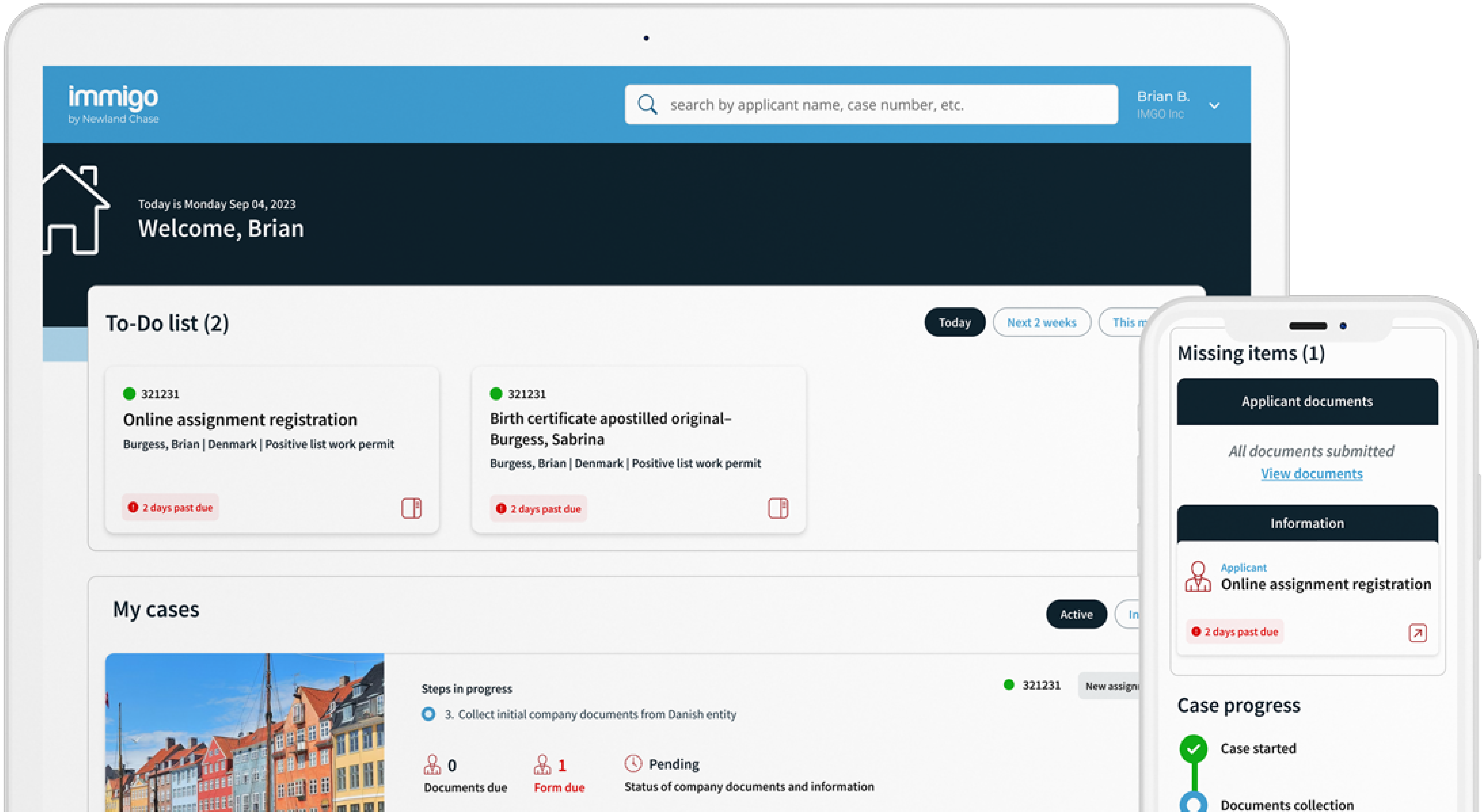Get The Visibility Your Company Needs
Reduce compliance risks and mobility costs while managing individual and project-related travel with ImmiSMART: the solution that unifies your travel and mobility programs.
Global Immigration 101: Schengen Visas
January 18, 2019
By Kent O’Neil
For successful mobility managers, school is always in session. In an industry where the only thing that is constant is everything is always changing… success depends on continually keeping abreast of new immigration rules and processes… and reminding ourselves of the same old basics vital to successful international assignments.
Whether you’re a “PhD” with years of handling your company’s international workforce… or the “new kid in class”, Newland Chase has you covered. Follow our continuing Global Immigration 101 blog series as each month we take a look at a different basic but vital aspect of immigration for short-term and long-term international business and work assignments. No tuition bills, student loans, number 2 pencils, term papers, end-of-semester exams, or all-nighters… just practical information and sage advice from the “real world” of mobility. (You’re welcome.) If you missed our last class session on “It’s Not Rocket Science… Supporting Documentation for Work Permit and Visa Applications, Authentication, Legalisation, and Apostille Simplified”… you can copy my notes here.
This week we delve into probably the most famous and common of all visas – the Schengen Visa. Last time I read it cover to cover… the official EU Handbook for the Processing of Visa Applications and the Modification of Issued Visas covering the Schengen Visa was 113 pages. Which begs the question…
Is There a “CliffsNotes” Version of the Schengen Visa Handbook?
Thankfully for our Global Immigration 101 readers, one of our clients recently asked me the same question. So I wrote one. If you’d like a formatted one-page printable pdf version to share with your team, feel free to email me at [email protected].
* * * * * * *
Schengen Visa Basics
The Schengen Area consists of 26 countries of Europe with a common set of visa rules on entry and short stays and a common external border. Internally, they have eliminated individual visa requirements and checks for borders between nations within the common Schengen Area. Currently, the Schengen Area includes:
| Austria | France | Latvia | Norway | Sweden |
| Belgium | Germany | Liechtenstein | Poland | Switzerland |
| Czech Republic | Greece | Lithuania | Portugal | |
| Denmark | Hungary | Luxembourg | Slovakia | |
| Estonia | Iceland | Malta | Slovenia | |
| Finland | Italy | Netherlands | Spain |
EU member states not included in the Schengen Area are Ireland, Croatia, Cyprus, Bulgaria, and Romania. (And obviously the United Kingdom, but that’s currently a much more complicated story.)
The two most common entry options into the common Schengen Area are:
- Visa Free – Entry into and movement throughout the Schengen Area for up to 90 days in any 180-day period without requirement of first obtaining a visa. Currently available for citizens of 61 nations – including all countries of North America, most of South America, Australia, and several countries of Asia. Citizens of all other countries require a Schengen C Visa prior to travel.
- Schengen C Visa – Entry into and movement throughout the Schengen Area for up to 90 days in any 180-day period with a Uniform Schengen Visa (USV) issued by a Schengen Area member state.
Schengen visas may also be issued as Airport Transit Visas or Limited Territorial Visas (allowing the holder to only enter and travel in certain named Schengen member states). There are also various Long-Term National Visas issued by the individual Schengen Area countries, which are often referred to incorrectly as “Schengen D Visas”.
Schengen C Visas
Entry Options: Schengen C Visas may be issued in single-entry, double-entry, and multiple-entry options – depending on the nature of the applicant’s entries and stays into the Schengen Area.
Application process: Applications for Schengen C Visas are lodged and processed at the consular post or visa processing centre of the country of main destination – i.e. the Schengen Area country in which most of the applicant’s time will be spent – or if no main destination, the country where the applicant will enter the Schengen Area. For most countries, application processing times are three (3) to ten (10) business days; but for some applicants, processing may stretch as long as 21 days. Note: Application requirements can vary by country; so always check requirements at the consular post or visa processing centre before applying.
Business Activities: Schengen C Visas are applicable for business activities. Permissible activities typically include: participation in meetings, seminars, conferences, and trade shows; conducting negotiations; purchasing goods; concluding contracts; prospecting for or exploring business opportunities; site visits; some services in connection with the purchase, supply, repair, or maintenance of equipment or products; and some limited training activities. Activities typically considered not permissible on a Schengen Visa include: any kind of employment (including self-employment) and participation in business operations. Note: Interpretations of permissible business activities can vary by country, consulate, case particulars, and consular officer.
Red flags: Common reasons for rejection of Schengen C Visa applications for business purposes include: security concerns; criminal background; invalid travel documents; insufficient explanation of purpose or details of travel; lack of invitation letter; insufficient proof of means; invalid travel insurance; and an unfavourable Schengen visa record. Note: If there are concerns over potential rejection, consult your immigration specialist prior to application.
UPDATE: Proposed Changes to the Schengen Visa
Some readers may recall that a three-month public consultation on “Modernising the EU’s Common Visa Policy” was completed early in 2018 – with numerous individuals and organisations (including Newland Chase) submitting written comments for improvement to be included in an upcoming reform measure. As a result of those comments, on 14 March last year, the European Commission made a number of proposals for reform, including:
- Faster and more flexible applications procedures;
- Multiple entry visas with longer validity;
- Short-term, single entry visas to be made available at border crossings;
- Additional resources (via a €20 fee increase) to improve security screenings; and
- Feasibility study on digital visas, including a digitised visa application process.
At present, the proposed reforms have been adopted by the European Economic and Social Committee (EESC) but have yet to be introduced to the European Parliament for action. Newland Chase continues to track the reforms through the legislative process, and we hope to report on action sometime in 2019.
Until next time…
Keep reading our alerts and blogs on the Newland Chase website at blog.newlandchase.com to keep on top of all the latest in global immigration news you can use. You can have all our alerts and educational resources conveniently emailed to you once each week by subscribing to our weekly newsletter on our home page here. For general inquiries regarding how Newland Chase can make your life easier in any of the 150+ countries where we operate and you do business, email us at [email protected].
This blog is informational only and is not intended as a substitute for legal advice based on the specific circumstances of a matter. Readers are reminded that immigration laws are fluid and can change at a moment’s notice without warning or notice. Please reach out to your Newland Chase contact should you require any additional clarification or guidance. Written permission from the copyright owner and any other rights holders must be obtained for any reuse of any content published or provided by Newland Chase that extend beyond fair use or other statutory exemptions. Responsibility for the determination of the copyright status and securing any permissions rests with those persons wishing to reuse this blog or any of its content.




